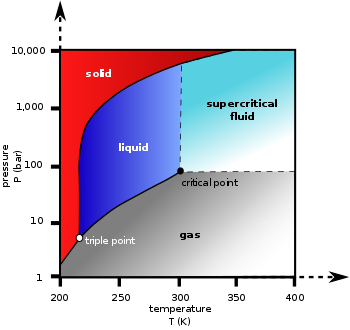Thermodynamic properties
| Phase behavior | |
|---|---|
| Triple point | 216.58 K (−56.57 °C), 518.5 kPa |
| Critical point | 304.18 K (31.03 °C), 7.38 MPa |
| Std enthalpy change of fusion, ΔfusH | 9.019 kJ/mol at triple point [5] |
| Entropy change of fusion, ΔfusS | 40 J/(mol·K) at triple point |
| Std enthalpy change of vaporization, [6] [7] ΔvapH | 15.326 kJ/mol at 215.7 K (−57.5 °C) (348 J/g) |
| Std entropy change of vaporization, ΔvapS | 70.8 J/(mol·K) |
| Solid properties | |
| Std enthalpy change of formation, ΔfH | −427.4 kJ/mol |
| Standard molar entropy, [8] S | 51.07 J/(mol·K) |
| Heat capacity, [8] cp | 2.534 J/(mol·K) at 15.52 K (−257.63 °C) |
| Liquid properties | |
| Std enthalpy change of formation, ΔfH | ? kJ/mol |
| Standard molar entropy, S | ? J/(mol K) |
| Heat capacity, [9] cp | 80—150 J/(mol·K) at 220—290 K |
| Gas properties | |
| Std enthalpy change of formation, ΔfH | −393.52 kJ/mol |
| Standard molar entropy, S | 213.79 J/(mol·K) |
| Heat capacity, [10] [11] cp | 33.89 J/(mol K) at –75 °C |
| Heat capacity ratio [10] γ = cp/cv | 1.37 at –75 °C |
| van der Waals' constants [12] | a = 363.96 L2 kPa/mol2 b = 0.04267 liter per mole |
| Equilibrium with carbon monoxide [13] CO + ½O2 → CO2 K = pK = log10K | pK = 45.0438 at T = 298.16 K |

![log of Carbon Dioxide vapor pressure. Uses formula
ln
[?]
P
mmHg
=
ln
[?]
760
101.325
-
24.03761
ln
[?]
(
T
+
273.15
)
-
7062.404
T
+
273.15
+
166.3861
+
3.368548
x
10
-
5
(
T
+
273.15
)
2
{\displaystyle \scriptstyle \ln P_{\text{mmHg}}=\ln {\frac {760}{101.325}}-24.03761\ln(T+273.15)-{\frac {7062.404}{T+273.15}}+166.3861+3.368548\times 10^{-5}(T+273.15)^{2}}
obtained from CHERIC LogCO2VaporPressure.png](http://upload.wikimedia.org/wikipedia/commons/2/23/LogCO2VaporPressure.png)



